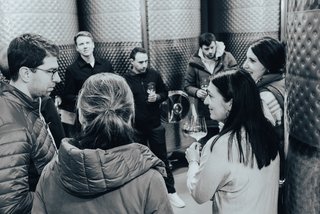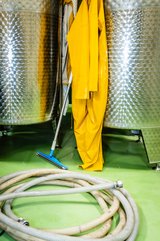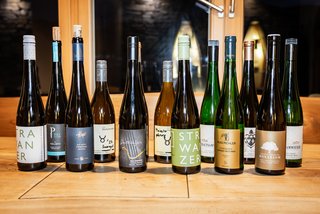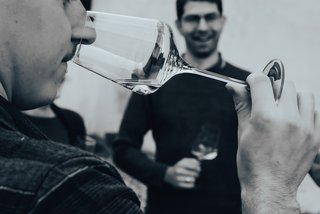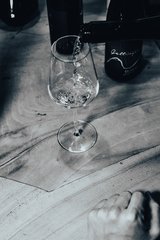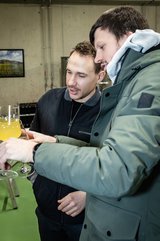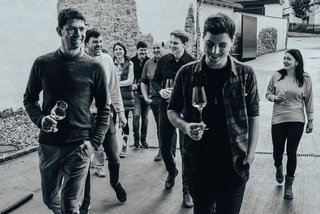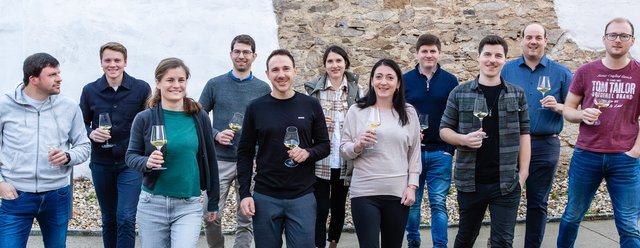
The smallest largest common denominator
Both among winegrowers and at Vinea Wachau, the new generation is taking over. The ‘youngsters’ meet to talk about the Wachau -- and about the new vintage.
1989. 1990. 1993. 1986. 1994. 1991. 1996. And 1997. More than one vintage is ready to take off, as a new generation of winegrowers poises to leave their mark on Vinea Wachau. We meet for a tasting at the Weingut Josef Fischer estate, where one more vintage is not to be missed. 2023. With the goblets filled with the first Federspiel wines, let’s get down to tasting.
About balance. In wine. Or whatever.
How is this youngster, the most recent vintage from the Wachau? This is no softy, all of us agree. “Less ice cream and more the cone, robust for sure but still trim and sleek,” as Franz Pichler puts it. And the alcohol content? Higher than last year’s but still makes for a good fit. “And that’s the main thing: the balance in wine. Besides, you can’t force anything. Some vintages have by nature less sugar, others more,” Christoph Donabaum explains.
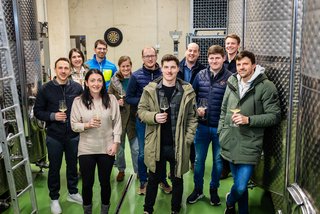
New ideas. Trusted traditions. Balance, and that goes for the Wachau on the whole, is what they are interested in. Many of these young winegrowers have travelled the planet on their internships. This generation prides itself in looking beyond the next hill. “When you get around, you get things back in perspective. My travels abroad showed me that we easily compare with anyone anywhere,” says Julia Donabaum. “I became aware of how much less we in the Wachau intervene during wine-making than people in other places. We can afford that because of our fantastic soils.”
Tradition means change.
To move the Wachau forward -- that’s our common goal. “Tradition is about progress. Even the most visible labels are constantly changing. But in a way so that you still always recognise them, Simon Gattinger observes.
Grüner Veltliner and Riesling. And Neuburger too ...
Many here see wine styles as moving in a fresher, lighter direction. They like to move up the harvest just a bit to let the acidity better shine through. “What strikes me as well is that our guests prefer to drink the wines typical for the region. In the Wachau, that means Grüner Veltliner and Riesling,” in Franz Pichler’s opinion. “But the special varieties, the niche wines, are also in demand. Here I’m thinking of our Neuburger,” Christoph Donabaum points out. Two leading varieties on the one side and a wide variety on the other? Perhaps the Wachau version of yin and yang.
And by the way, what does “Wachau” mean to the new generation? Unique. Inimical. Tense. Exciting. From every corner a different descriptor. “We’re the world’s smallest largest winegrowing region,” Hanna Hirtzberger roars with a laugh. “In what other region do so many winegrowers manage such high-quality output within such a small space?” That says it for everyone. As does the commitment to purity: Wachau on the bottle means Wachau is in it. Or, protection of origin is the path to follow, despite less freedom and higher risk. Because there’s is only one Wachau. That’s our common commitment.
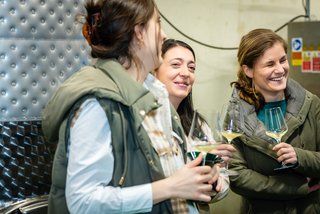
- Weingut HöglMember of Vinea in Spitz
- Weingut TrautsamwieserMember of Vinea in Weissenkirchen
- Weingut PAXMember of Vinea in Wösendorf
- Weinhofmeisterei HirtzbergerMember of Vinea in Wösendorf
- Winzerhof PöchlingerMember of Vinea in Mitterarnsdorf
- Weingut Franz StierschneiderMember of Vinea in Weissenkirchen
- Weingut Christoph DonabaumMember of Vinea in Spitz
- Weingut Rudi PichlerMember of Vinea in Wösendorf
- Weingut Simon GattingerMember of Vinea in Unterloiben
- Weingut Josef FischerMember of Vinea in Rossatz
- Weingut Strawanzer - DonabaumMember of Vinea in Spitz
